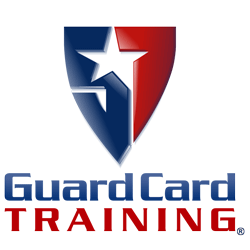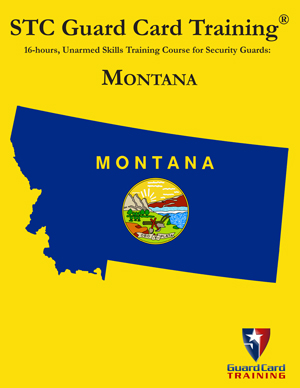
Montana Security Guard Training Manuals
Montana Board of Private Security (BPS)
These training manuals and materials are intended for use as part of an instructor-led course in accordance with the Administrative Rules of Montana. These materials may be used exclusively by BPS-licensed security officer trainers in approved and licensed training facilities or by licensed private or proprietary security officer agencies or business providers.
Our training complies with the Montana Board of Private Security regulations, Administrative Rules of Montana, Department 24, Labor and Industry, Chapter 24.182, Subchapter 8 Training Programs, §24.182.807 Private Security Guard Training Program.
Price: $84.99 (plus tax, shipping/handling)
We have no annual license or membership fees.

16-hours, Unarmed Skills Training Course for Security Guards: Montana
276 pages.
Every lesson includes Knowledge Checks and References for further study.
This manual is divided into fourteen (14) lessons:
- Lesson 1: Introduction
- Lesson 2: Power to Arrest
- Lesson 3: Searches
- Lesson 4: Evidence
- Lesson 5: Use of Force
- Lesson 6: Legal Liability
- Lesson 7: Documentation and Report Writing
- Lesson 8: Access Control
- Lesson 9: Counterterrorism
- Lesson 10: Fundamentals of Patrolling
- Lesson 11: Ethics
- Lesson 12: Professionalism
- Lesson 13: Handling Difficult People
- Lesson 14: Introduction to Fire Patrol and Life Safety
Lesson 1: Introduction
Back to topObjectives:
- Recognize Responsibility and Authority of a Security Guard.
- Understand Laws and Regulations pertaining to private security work.
- Properly wear uniforms and display identification.
- Know requirements to obtain and maintain private security permit.
Lesson 2: Power to Arrest
Back to topObjectives:
- Describe the law of arrest as it pertains to private security in Wisconsin.
- Differentiate the fundamentals of criminal law as it pertains to private security.
- Recognize the Wisconsin State Statutes.
- Explain differences between detention and arrest.
- Summarize and define false imprisonment.
- Describe how to properly apply handcuffs
- Know the responsibilities of a private security guard.
Lesson 3: Searches
Back to topObjectives:
- Define seizure as it applies to private citizens.
- Describe the limits of search and seizure as it applies to private security in Wisconsin.
- Interpret the Wisconsin State Statutes.
- Conduct an appropriate area search.
- Protect an incident scene.
- Conduct an appropriate frisk.
- Understand the limits of searches during a detention.
Lesson 4: Evidence
Back to topObjectives:
- Identify common forms of evidence.
- Explain proper care and handling of evidence.
- Summarize the correct procedure to secure a scene.
- Describe common legal issues regarding evidence.
- Collect appropriate information from witnesses.
- Identify types of evidence.
Lesson 5: Use of Force
Back to topObjectives:
- Describe the law of arrest as it pertains to private security in the Wisconsin.
- Paraphrase the responsibilities of a private security guard.
- Recognize the Wisconsin State Statutes.
- Interpret the appropriate use of reasonable force.
- Describe the Use of Force Continuum/Ladder.
- Explain the use of restraint techniques and their implications.
- Explain the use of deadly force.
- Recognize pre-assault indicators.
- Describe the use of force in property defense.
- Explain escalation and de-escalation techniques in the use of force.
Lesson 6: Legal Liability
Back to topObjectives:
- Define the difference between the court proceedings and the burden of proof for criminal and civil courts.
- Describe the penalties for criminal prosecution and civil litigation.
- Understand the personal liability of security guard.
- Define liability of the guard company.
- Define liability of the client.
- Describe differences between the criminal and civil process.
- Describe the role of the security guard.
Lesson 7: Documentation and Report Writing
Back to topObjectives:
- Write an effective report.
- Take descriptive and useful field notes.
- Demonstrate objectivity in report writing.
- Complete common types of reports.
Lesson 8: Access Control
Back to topObjectives:
- Describe access control.
- Interpret the fundamentals of manual access control systems.
- Interpret the fundamentals of automated access control systems.
- Apply identification procedures to on-site personnel.
- Explain the fundamentals of alarm systems.
- Describe the fundamentals of trespass.
Lesson 9: Counterterrorism
Back to topObjectives:
- Identify functions of major counterterrorism agencies.
- Describe the nature of terrorism.
- Explain the goals of terrorism.
- Describe the differences between homegrown violent extremists and international terrorism.
- Identify the common homegrown violent extremists and organization goals.
- Identify suspicious behavior.
- Better protect their post from terrorist threats.
Lesson 10: Fundamentals of Patrolling
Back to topObjectives:
- Apply appropriate patrolling techniques and methods.
- Describe how to handle suspicious activity.
- Explain how to ask appropriate questions.
- Apply accident and fire prevention techniques.
- Properly employ all senses in observation.
- Conduct an efficient and productive patrol.
- Conduct an appropriate interview.
Lesson 11: Ethics
Back to topObjectives:
- Recognize and avoid gender and racial harassment.
- Recognize and avoid discrimination.
- Develop respect of others.
- Understand the principles of ethical behavior.
- Describe how to avoid conflicts of interest.
- Identify ethical violations.
- Explain how to report unethical behavior.
Lesson 12: Professionalism
Back to topObjectives:
- Know how to project a friendly, professional image.
- Describe the importance of positive public relations.
- Demonstrate Command Presence.
- Understand the sources of power.
- Explain the importance of maintaining a clean, sharp uniform.
- Define good public relations.
Lesson 13: Handling Difficult People
Back to topObjectives:
- Summarize four specific reasons why consumers may become violent.
- Identify personal reactions to confrontation.
- Describe personal Risk Factors related to violent behavior.
- Explain the Stress Model.
- Discuss the Theoretical Models of Assault.
- Define how the working environment can affect behavior.
- Configure a safe working environment.
Lesson 14: Introduction to Fire Patrol and Life Safety
Back to topObjectives:
- Understand fire safety
- Understand the three elements necessary for fire
- Recognize common fire safety hazards
- Safely take action in the event of a fire
- Understand fire life-safety
- Understand various fire protection systems
Licensing Contact
For more information on our licensing programs, please contact:


